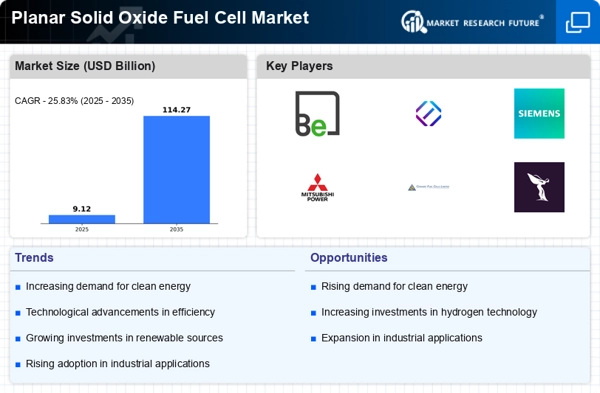Technological Innovations
Technological advancements are playing a pivotal role in shaping the Planar Solid Oxide Fuel Cell Market. Innovations in materials science, such as the development of advanced electrolytes and electrodes, are enhancing the performance and durability of these fuel cells. Research and development efforts are focused on improving the efficiency and reducing the costs associated with planar solid oxide fuel cells. Furthermore, the integration of digital technologies, such as IoT and AI, is enabling better monitoring and optimization of fuel cell systems. These innovations not only improve the operational efficiency of fuel cells but also make them more competitive against other energy technologies. As these advancements continue, the market is likely to see increased adoption across various sectors.
Increasing Energy Efficiency
The Planar Solid Oxide Fuel Cell Market is witnessing a surge in demand for energy-efficient solutions. These fuel cells are known for their high efficiency, often exceeding 60%, which is significantly higher than traditional combustion-based power generation methods. This efficiency translates into lower operational costs and reduced greenhouse gas emissions, aligning with global sustainability goals. As industries and governments prioritize energy efficiency, the adoption of planar solid oxide fuel cells is likely to increase. Furthermore, the potential for combined heat and power applications enhances their appeal, as they can simultaneously generate electricity and useful heat. This dual functionality positions the planar solid oxide fuel cell as a compelling option for various sectors, including residential, commercial, and industrial applications.
Rising Industrial Applications
The Planar Solid Oxide Fuel Cell Market is experiencing growth due to the increasing adoption of fuel cells in various industrial applications. Industries such as manufacturing, transportation, and power generation are exploring the benefits of these fuel cells for their energy needs. The ability of planar solid oxide fuel cells to operate at high temperatures makes them suitable for integration into existing industrial processes. Moreover, the market for fuel cells in transportation is expanding, with applications in electric vehicles and heavy-duty transport. According to recent estimates, the industrial segment is projected to account for a substantial share of the market, indicating a shift towards cleaner energy solutions in traditionally high-emission sectors.
Supportive Regulatory Frameworks
The regulatory landscape surrounding the Planar Solid Oxide Fuel Cell Market is becoming increasingly favorable. Governments are implementing policies and incentives aimed at promoting clean energy technologies. For instance, tax credits, grants, and subsidies for renewable energy projects are encouraging investments in fuel cell technologies. Additionally, stringent emissions regulations are pushing industries to seek cleaner alternatives, further driving the demand for planar solid oxide fuel cells. The alignment of these regulatory measures with international climate agreements suggests a robust future for the market. As more countries commit to reducing carbon footprints, the adoption of planar solid oxide fuel cells is expected to gain momentum, supported by favorable government initiatives.
Growing Investment in Renewable Energy
Investment in renewable energy sources is a key driver for the Planar Solid Oxide Fuel Cell Market. As the world shifts towards sustainable energy solutions, funding for clean technologies, including fuel cells, is on the rise. Venture capital and government funding are increasingly directed towards research and development in fuel cell technologies. This influx of capital is expected to accelerate innovation and commercialization efforts, making planar solid oxide fuel cells more accessible to a broader range of applications. The increasing focus on energy independence and security further emphasizes the need for reliable and efficient energy solutions, positioning the planar solid oxide fuel cell as a viable option in the renewable energy landscape.


















Leave a Comment